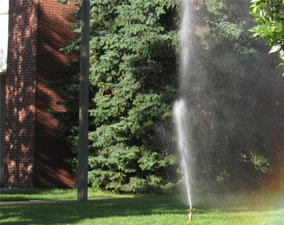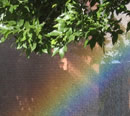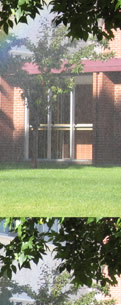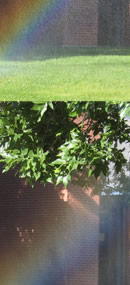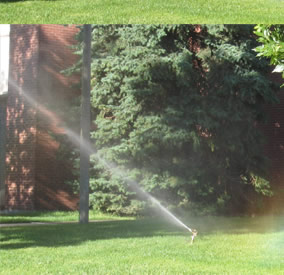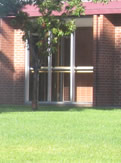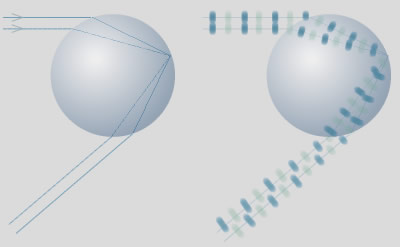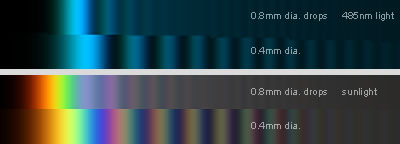
OpticsPOD
What's New
Rays & Shadows
Water Droplets
Rainbows
Not a rainbow!
Primary Bow
Raindrop Rays
Rainbow Cone
Low & High Bows
Drop size
Colours
Secondary Bow
A's Dark Band
Other Orders
Supernumeraries
Red Bows
Rainbow Wheel
Dew Bow
Sea Spray Bow
Glass Bead Bows
Reflection Bows
Twinned Bows
Cloud Bows
Moon Bows
Image Gallery
Simulators
Ice Halos
High Atmosphere
Links & Resources
Search - Index
123456789012345678
| Primary Rainbow drop size |
|
|||||||||||||||||||||||
| Lawn sprinkler bow, MSU Bozeman MT. As the jet rotated the bow width changed and the colours varied from bright and saturated colours to pastel hues. Image ©Les Cowley |
A bow's appearance depends on drop size. The
best are narrow ones with intense colours and these are made by
large drops several mm in diameter. Look for them during very heavy
showers.
Smaller drops produce broader bows with less saturated colours. Very
small drops give nearly colourless cloudbows and fogbows.
The sprinkler's drops were largest near the main jet and they produced
the narrow colourful bow. After the jet had rotated away and the large
drops had fallen to earth the remaining smaller drops made the broader
pastel bow.
 |
Classical geometric
optics cannot explain the the change in appearance
and dependence on drop size . We must invoke
the wave behaviour of light. Classically, each angle of the rainbow is made up of light that has traveled through drops along two different paths. Again classically, the two emerging ray intensities simply add together.
A critical feature is that the paths have different lengths. The crests start in step as they travel towards the drop but, as a consequence of the different entrance points and path lengths, they can emerge from the drop out of step - there is a phase difference. The emergent wave intensities cannot simply be added because the waves interfere. When the crests are completely out of phase their positive and negative amplitudes cancel and there is little light, when in phase the light is intensified. The phase difference and interference varies as the the rainbow deflection angle changes. The result is a peak in intensity near the classical rainbow angle with oscillatory fringes, supernumeraries, inside it. The key to the changing appearance of the sprinkler bow is that as the drop size decreases the phase difference changes more slowly with angle. The main rainbow peak therefore broadens and any supernumeraries are more widely spaced. Differences in colour with drop size? The sunlight bow is a superimposition of monochromatic light bows. When the bows are broadened, the different colours overlap more and the resultant hues are less saturated and pastel. |
| * | This is diagrammatic but a reasonable representation for rainbow forming droplets 0.3mm dia. and upwards. |
| ** | Light waves are transverse, the electric oscillations are at right angles to the wave travel. The direction of the electric vibration, the electric vector, determines the polarisation of the light. Unpolarised light has, over a short time period, electric vectors in all directions perpendicular to the ray direction. Pure plane polarised light has the electric vectors in a single direction. The intensity of light on being reflected or refracted depends on the direction of the initial polarisation relative to the surface. Rotate a pair of sunglasses while looking at a reflection in glass to show this. Rainbows are therefore polarised (rotate sunglasses while viewing one). Polarisation does not invalidate the above qualitative explanation but it does affect the quantitative description of rainbows and fogbows. |
| *** | The simulations are for a 0.5° diameter source, sun sized, and droplets all of one size. In nature, far fewer supernumeraries (if any) are visible because there is a distribution of drop sizes and larger drops are flattened to some extent. |
